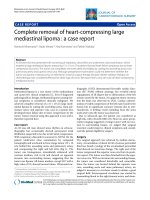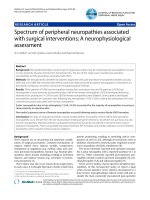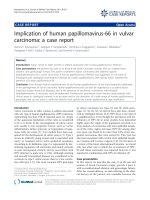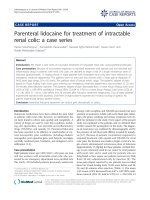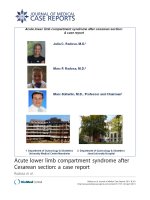Báo cáo y học: " Adult granulosa cell tumor associated with endometrial carcinoma: a case report" pps
Bạn đang xem bản rút gọn của tài liệu. Xem và tải ngay bản đầy đủ của tài liệu tại đây (1.88 MB, 5 trang )
CAS E REP O R T Open Access
Adult granulosa cell tumor associated with
endometrial carcinoma: a case report
Cornelius O Ukah
1
, Okechukwu C Ikpeze
2
, George U Eleje
2
and Ahizechukwu C Eke
3*
Abstract
Introduction: If strict criteria for the diagnosis of carcinoma are used and all patients with granulosa cell tumors
are considered, the best esti mate of the incidence of associated endometrial carcinomas is under 5%. In patients
with granulosa cell tumors, estrogen-dependent endometrial cancers are rarely found, and most of these
endometrial cancers are well-differentiated endometrioid adenocarcinomas that carry a good prognosis when
detected early.
Case presentation: We report the case of a 65-year-old post-menopausal Nigerian woman of the Igbo tribe with
an adult granulosa cell tumor that was initially treated as endometrial carcinoma. She underwent a total abdominal
hysterectomy and a bilateral salpingo-oophorectomy after histopathologic confirmation of a well-differentiated
granulosa cell tumor of the ovary and a nuclear grade 1 adenocarcinoma of the endometrium (International
Federation of Obstetricians and Gynecologists stage 1B). She had a good post-operative recovery and was
discharged 10 days after treatment.
Conclusion: The association between adult granulosa cell tumors of the ovary and endometrial carcinomas is rare.
A high index of suspicion as well as good imaging and histopathologic analyses are important in making this
diagnosis.
Introduction
Adult granulosa cell tumors account for approximately
1% to 2% of all ovarian tumors and 95% of all granulosa
cell tumors [1]. They occur more often in post-meno-
pausal than pre-menopausal women, with a peak inci-
dence between 50 and 55 years of age. They are the
most common estrogenic ovarian tumors diagnosed
clinically, but the precise proportion of adult granulosa
cell tumors that secrete hormones is difficult to establish
because an endometrial tissue specimen used to evaluate
the effects of estrogenic stimulation is often unavailable.
The typical endometrial reaction associated with func-
tional tumors in this category is simple hyperplasia that
usually exhibits some degree of pre-cancerous atypical-
ity. Reports of the incidence of an a ssociated endome-
trial carcinoma, which almost always is well
differentiated, have ranged from slightly less than 5% to
slightly more than 25% of cases [1,2]. The wide variation
in these figures is attributable at least in part to differing
views of the dividing line between complex atypical
hyperplasia and grade 1 adenocarcinoma. If strict cri-
teria for the diagnosis of carcinoma are used and all
patient s with granulosa cell tumors, not only those who
have undergone e ndometrial curettage or hysterectomy,
are considered, the b est estimate of the incidence of an
associated endometrial carcinoma is under 5% [1].
Case presentation
We present the case of a 65-year-old, para 11, Nigerian
woman of the Igbo tribe with 10 living children. She
was six years post-menopausal and had borne her last
child 26 years before presentation to our hospital. She
presented with a three-week history of post-men opausal
bleeding. The vaginal bleeding was sudden in onset and
profuse, with occasional passage of blood clots. She had
no history of dizziness or fainting. She had associated
intermit tent lower abdominal pain that was du ll, 4 of 10
in intensity, with no relieving or aggravating factors. She
had no history of post-coital or co ntact bleeding, weight
* Correspondence:
3
Health Policy and Management concentration, Masters in Public Health
Program, Harvard School of Public Health, 677 Huntington Avenue, Boston,
MA 02115, USA
Full list of author information is available at the end of the article
Ukah et al . Journal of Medical Case Reports 2011, 5:340
/>JOURNAL OF MEDICAL
CASE REPORTS
© 2011 Ukah et al; licensee BioMed Central Ltd. This is an Open Access a rticle distributed under the terms of the Cr eative Co mmons
Attribution License ( w hich permits unrestricted use, distribution, and reproduction in
any medium, provided the original work is properly cited.
loss, anorexia, urinar y symptoms, abdominal mass, vagi-
nal discharge, or dyspareunia. She had no history of the
use of hormonal contraceptives or ovulation-inducing
drugs. She had no family history of a similar illness. She
had attained menarche a t the age of 15 years, and her
coitarche occurred at age 16 yea rs. She had not had any
Papanicolao u smears in the past. She was not known to
have diabetes or hypertension, and she neither smoked
cigarettes nor drank alcohol.
An endometrial tissue biopsy was done in a private
hospital. The histology revealed a well-differentiated
endometrial adenocarcinoma. She was subsequently
referred to our teaching hospital for further manage-
ment. Upon presentation to our teaching hospital, her
physical examination revealed an elderly woman in no
distress who was afebrile (body temperature 37.1°C), not
pale, and anicteric. She was not dehydrated. No periph-
eral lymphadenopathies and no pedal edema were pre-
sent. Her pulse rate was 90 beats/minute, regular, and
with a full volume. Her blood pressure was 170/90
mmHg. S1 and S2 heart sounds were heard, and there
were no murmurs, rubs, or gallops. Her jugular venous
pressure was not increased. Her respiratory rate was 22
cycles/minute, and her chest was clinically clear with
vesicular breath sounds. The findings of the abdominal
examination were normal.
The vaginal examination revealed an atrophic, blood-
stained vulvovagina. A speculum examination showed
an apparently healthy-looking cervix. The cervical os
was found to be closed on digital examinat ion. A
bimanual examination revealed a bulky uterus that was
about 16 weeks’ g estational size. It was freely mobile
and anteverted. There was no adnexal mass or tender-
ness, and there was no cervical excitation tenderness.
A clinical diagnosis of post-menopausal bleeding sec-
ondary to endometrial carcinoma and essential hyper-
tension was made. She was admitted to the gynecology
ward. Her pa cked red blood cell vol ume was 33%, and
thetotalwhitebloodcellcountwas3.4×10
9
/L. The
human immunodeficiency virus screening results were
negative. The urine analysis, renal function test, liver
function test, electrocardiography, and the fasting lipid
profile results were all no rmal. A chest radiograph
revealed mild cardiomegaly. Abdominopelvic ultrasono-
graphy showed an enlarged ute rus with an endometrial
thickness of 15 mm. There were no obvious hepatic
lesions, and there was no hydronephrosis.
In view of the patient’s co-existing essential hyperten-
sion, the cardiology team was invited to co-manage the
patient. She was prescribed tablet amlodipine ( 5 mg/
day), hydrochlorothiazide (25 mg/day), and tablet aspirin
(75 mg/day, including hematinics). She was also coun-
seled r egarding total abdominal hysterectomy and
bilateral salpingo-oophorectomy that would be per-
formed after her blood pressure had stabilized.
Three weeks after initiation of her anti-hypertension
therapy, she underwent a total abdominal hysterectomy
and a bilateral salpingo-oophorec tomy while under gen-
eral anesthesia with endotracheal intubation. The intra-
operative findings included a bulky uterus that measured
8 cm × 5 cm with a blood-filled cavity, an enlarged,
malignant-looking endometrium, and a massive hemo-
peritoneum from a ruptured soft but malignant-looking
huge friable left ovarian mass that measured 5 cm × 5
cm in diameter. Her fallopian tube s and right ovary
appeared to be healthy. The estimated blood lo ss was
750 mL. The patient received 2 U of blood and 1 g of
intravenous ceftriaxone intra-operatively. The patient’ s
immediate post-operative condition was satisfactory. All
of the surgical specimens were immersed in containers
containing appropriate volumes and concentrations of
10% formalin and sent to the histopathology department
for histologic diagnoses. After surgery, the p atient
received intravenous fluid of 1 L of normal saline alter-
nated with 1 L of 5% dextrose water on a 12-hourly
schedule, as well as intravenous ceftriaxone (1 g/day)
and metronidazole (500 mg every 8 hours for 48 hour s).
She also received a 30 mg pentazocine intra-muscular
injection every six hours for 48 hours. Forty-eight hours
after surgery she was placed on oral medications for the
next 5 da ys. She also received hematinics 48 hours after
surgery. The urethral catheter was removed 48 hours
after surgery. She was continued on oral anti-hyperten-
sive agents after surgery. The stitches were removed on
the seventh day after surgery. She was discharged to
home on the 10th post-operative day and was scheduled
for a two-week follow-up appointment.
Macroscopically, the pathology report showed a left
ovarian mass. This was a huge, soft to firm, nodular
mass weighing 1500 g and measuring 8 cm in its largest
dimension. A cut section showed predominantly solid,
partly grayish white and partly yellow areas as well as
cystic areas filled with blood clots. The uterus was bulky
and weighed 700 g. I t measured 13.5 cm in its largest
dimension. A cut into the endometrial cavity showed
several fingerlike friable masses filling the whole uterine
cavity. No lesions were observed on the right ovary or
the right and left fallopian tubes. Histologic sections of
the left ovarian mass showed a granulosa cell tumor
containing coffee bean cells growing in different charac-
teristic patterns seen in the tumor. Figures 1 and 2 are
photomicrographs of the ovarian mass. Histologic sec-
tions of the uterine mass showed a well-differentiated
grade 1 endometrioid carcinom a minimally invading the
adjacent myometrium. Figures 3 and 4 are photomicro-
graphs of the uterine mass.
Ukah et al . Journal of Medical Case Reports 2011, 5:340
/>Page 2 of 5
At the two-week follow-up visit after surgery, the
patient no longer had vaginal bleeding. Her vital signs
were normal, and her abdominal wound was well
healed. She was last seen six weeks after surgery and
had no new complaints. She was advised to continue
her follow-up care with the gynecology and cardiology
teams at our teaching hospital.
Discussion
Adult granulosa cell tumors account for approximately
95% of all granulosa cell tumors [1]. We have yet to
record any case of a juvenile granulosa cell tumor at our
center. Adult granulosa cell tumors occur more often in
post-menopausal than pre-menopausal women [1]. This
was the case with our patient, who was post-menopau-
sal. If strict criteria for the diagnosis of carcinoma are
used and all patients with a granulosa cell tumor, not
only those who have undergone endometrial curettage
or hysterectomy, are considered, the best estimate of the
incidence of associated endometrial carcinomas is under
5% [1]. Our patient presented to our teaching hospital
with the first case of granulosa cell tumor and an asso-
ciated endometrial carcinoma managed in our institu-
tion since it was established 20 years ago. We have seen
only 21 cases of isolated granulosa cell tumors of the
ovary, all o f the adult type, since the establishment of
the histopathology department at our center. Thus, this
puts the incidence of endometrial carcinoma associated
with granulosa cell tumor in our center at 4.8%.
Endometrial cancer has been described as consisting
of two groups. The first group (type 1, comprising about
80% of the cases) is characterized by well-differentiated
tumors that present with localized disease. These
patients usually have a favorable outcome [2,3]. The
development of type 1 endometria l cancer is associated
with excessive estrogen exposure. The risk factors for
type 1 endometrial carcinoma include obesity, nulliparity
with a history of infertility, late menopause, diabetes
mellitus, unopposed estrogen therapy, tamoxifen ther-
apy, and the use of sequential oral contraceptive pills.
Excess estrogen from any of these sources produces
continuous stimulation of the endometrial lining, which
can result in endometrial hyperplasia and can potentially
lead to endometrial cancer [4,5].
Ovarian cancers can present asepithelialcelltumors,
germ cell tumors, or sex cord-stromal cell tumors [6].
Granulosa cell tumors are classified as germ cell ovarian
tumors. These ovarian germ cell tumors may be benign
or malignant [6]. Malignant ovarian germ cell tumors
are rare, accoun ting for about 2% to 5% of all ovarian
Figure 1 Photomicrograph showing the ovarian mass.
Figure 2 Photomicrograph showing the ovarian mass.
Figure 3 Photomicrograph showing the uterine mass.
Figure 4 Photomicrograph showing the uterine mass.
Ukah et al . Journal of Medical Case Reports 2011, 5:340
/>Page 3 of 5
malignancies. However, they are the most common form
of ovarian cancer in the first two decades of life. All
germ cell t umors arise from the germ cells of the ovary
(the oocytes) and are classified according to the type of
cell from which they are produced. Ovarian germ cell
tumors are classified as dysgerminomas, yolk sac
tumors, embryonal carcinomas, polyembryomas, non-
gestational choriocarcinomas, teratomas, and mixed
germ cell tumors [7]. These cell line origins of germ cell
tumors determine the type of proteins they express.
Trophoblast-derived tumors produce trophoblastic hor-
mones, particularly human chorionic gonadotropin, but
yolk sac tumors produce a-fetoprotein. Both are used in
the pre-operative assessment of germ cell tumors and in
post-operative follow-up [7].
Teratomas are the commonest type of germ cell
tumors that do not produce any particular blood mar-
kers. Dysgerminomas are undifferentiated tumors, and,
as such, they express the hormonal markers demon-
strated by a choriocarc inoma or yolk sac tumor. How-
ever, they can also produce other placental hormones,
such as placental alkaline phosphatase and lactate dehy-
drogenase [7].
Granulosa cell tumors cause endometrial cancer by
virtue of continuous and unopposed estrogen secretion
by the ovary [8]. The microscopic appearance of an
endometrioid carcinoma is determined by the grade of
the tumor. Grading is based on the architectural pattern
of the tumor, its nuclear features, or both. The architec-
tural grade is determined by the extent to which the
tumor is composed of solid masses of cells compared
with well-defined glands. The nuclear grade is deter-
mined by the variation in nuclear size and shape, chro-
matin distribution, and size of the nucleoli. Grade 1
nuclei are oval and mildly enlarged and have evenly dis-
persed chromatin. Grade 3 nuclei are markedly enlarged
and pleomorphic, with irregular coarse chromatin and
prominent eosinophilic nucleoli. The most recent revi-
sions of the International Federation of Obstetricians
and Gynecologists (FIGO) Staging System and the
World Health Organization Histopathol ogic Classifica-
tion of uterine carcinoma recommend that tumors be
graded using both architectural and nuclear criteria. The
grade of tumors that are architecturally grade 1 or 2
may be increased by one grade in the presence of “nota-
ble” nuclear atypia, defined as grade 3 nuclei [9].
Myometrial invasion is an independent predictor of
outcome [10,11]. A study of more than 400 patients
with clinical stage I endometrioid carcinoma revealed
that the 5-year survival rates were 94% when the tumo r
was confined to the endometrium, 91% when the tumor
involved the inner third of the myometrium, 84% when
the tumor extended into the middle third of the myo-
metrium, and 59% when the tumor infiltrated the outer
third of the myometrium [12]. After s urgery, patients
are classified as being at low, intermediate, or high risk
based on surgical pathologic staging. Patients with grade
1 or 2 tumors that are confined to the endometrium or
are minimally invasive are defined as being at l ow risk
and require no further therapy [7,13].
In patients with granulosa cell tumors, estrogen-
dependent endometrial cancers can be found, and most
of them are well-differentiated endometrioid adenocarci-
nomas that carry a good prognosis when detected early
[11]. This was the case with our patient, who had a
well-di fferentiated, nuclear grade 1 endometrioid adeno-
carcinoma and FIGO stage 1B disease. This explains
why surgery alone was offered to her as a treatment
option. Her condition at her follow-up examination six
weeks after surgery was satisfactory.
Conclusion
Because we experienced this case as the first case of an
adu lt granulosa cell tumor asso ciated with a well-differ-
entiated, nuclear grade 1 endometrioid adenocarcinoma
in our center, we decided to report it to aler t the obste-
trics and gynecology community to have heightened
clinical suspicion of endometrial carcinoma any time
that a diagnosis of granulosa cell tumor is made.
Consent
Written informed consent was obtained from the patient
for publication of this case report and any accompany-
ing images. A copy of the writ ten consent is availabl e
for review by the Editor-in-Chief of this journal.
Author details
1
Department of Histopathology, Nnamdi Azikiwe University Teaching
Hospital, Nnewi, Anambra State, Nigeria.
2
Department of Obstetrics and
Gynecology, Nnamdi Azikiwe University Teaching Hospital, Nnewi, Anambra
State, Nigeria.
3
Health Policy and Management concentration, Masters in
Public Health Program, Harvard School of Public Health, 677 Huntington
Avenue, Boston, MA 02115, USA.
Authors’ contributions
OCI performed the surgery and assisted in the writing of the manuscript
and in the gynecologic work-up of the patient. COU worked on preparing
the pathologic slides, assisted in the drafting of the manuscript, and
performed PubMed research. GUE performed the gynecologic work-up of
the patient and assisted in the writing of the manuscript. ACE performed
PubMed research and critically revised the manuscript. All authors read and
approved the final manuscript.
Competing interests
The authors declare that there is no financial support or relationship that
may pose any conflict of interest. The research was funded by the authors.
Received: 4 February 2011 Accepted: 2 August 2011
Published: 2 August 2011
References
1. Young RH, Scully RE: Sex cord-stromal, steroid cell, and other ovarian
tumours, and paraneoplastic manifestations. Blaustein’s Pathology of the
Female Genital Tract. 5 edition. New Delhi: Springer-Verlag; 2002, 907-917.
Ukah et al . Journal of Medical Case Reports 2011, 5:340
/>Page 4 of 5
2. Deligdisch L, Holinka CF: Endometrial carcinoma: two diseases? Cancer
Detect Prev 1987, 10:237-246.
3. Bokhman JV: Two pathogenic types of endometrial carcinoma. Gynecol
Oncol 1983, 15:10-17.
4. Gates EJ, Hirschfield L, Matthews RP, Yap OW: Body mass index as a
prognostic factor in endometrioid adenocarcinoma of the endometrium.
J Natl Med Assoc 2006, 98:1814-1822.
5. Balen AH: Polycystic ovary syndrome and cancer. Human Reprod Update
2001, 7:522-525.
6. Serov SF, Scully RE, Sobin LH: Histological Typing of Ovarian Tumors.
International Histological Classification of Tumors, No. 9 Geneva: World
Health Organization; 1973.
7. Gershenson DM: Management of ovarian germ cell tumors. J Clin Oncol
2007, 25:2938-2943.
8. Pekin T, Yoruk P, Yıldızhan R, Yıldızhan B, Ramadan S: Three synchronized
neoplasms of the female genital tract: an extraordinary presentation.
Arch Gynecol Obstet 2007, 276:541-545.
9. Brigitte MR, Richard JZ, Lora HE, Robert JK: Endometrial carcinoma.
Blaustein’s Pathology of the Female Genital Tract. 5 edition. New Delhi:
Springer-Verlag; 2002, 503-520.
10. Morrow CP, Bundy BN, Kurman RJ, Creasman WT, Heller P, Homesley HD,
Graham JE: Relationship between surgical-pathologic risk factors and
outcome in clinical stage I and II carcinoma of the endometrium: a
Gynecologic Oncology Group study. Gynecol Oncol 1991, 40:55-65.
11. Gruber SB, Thompson WD: A population-based study of endometrial
cancer and familial risk in younger women. Cancer and Steroid
Hormone Study Group. Cancer Epidemiol Biomarkers Prev 1996, 5:411-417.
12. Zaino RJ, Kurman RJ, Herbold D: The significance of squamous
differentiation in endometrial carcinoma. Cancer 1991, 68:2293-2302.
13. Lee SE, Kim DK, Ahn YS: A case of adult granulosa cell tumors associated
with endometrial carcinoma. Korean J Obstet Gynecol 2002, 45:855-859.
doi:10.1186/1752-1947-5-340
Cite this article as: Ukah et al.: Adult granulosa cell tumor associated
with endometrial carcinoma: a case report. Journal of Medical Case
Reports 2011 5:340.
Submit your next manuscript to BioMed Central
and take full advantage of:
• Convenient online submission
• Thorough peer review
• No space constraints or color figure charges
• Immediate publication on acceptance
• Inclusion in PubMed, CAS, Scopus and Google Scholar
• Research which is freely available for redistribution
Submit your manuscript at
www.biomedcentral.com/submit
Ukah et al . Journal of Medical Case Reports 2011, 5:340
/>Page 5 of 5
